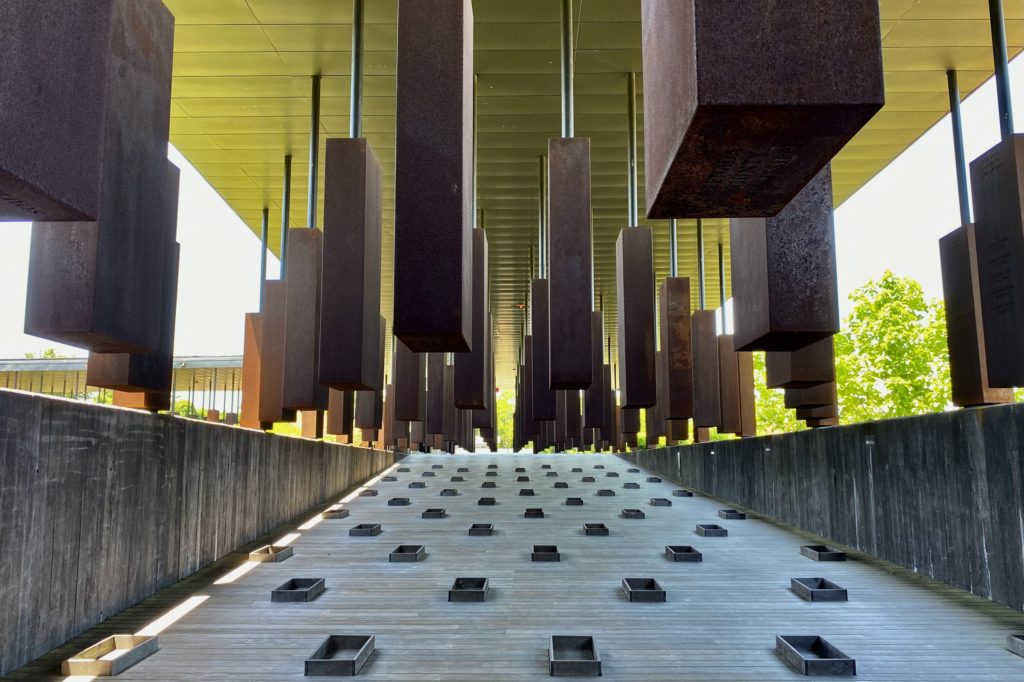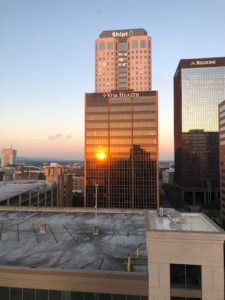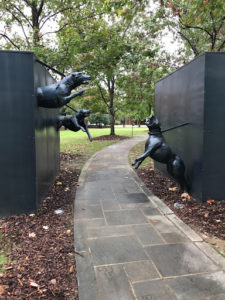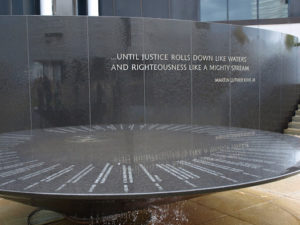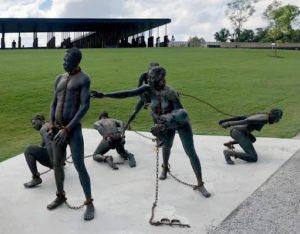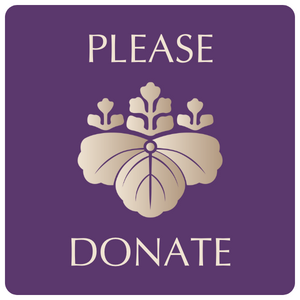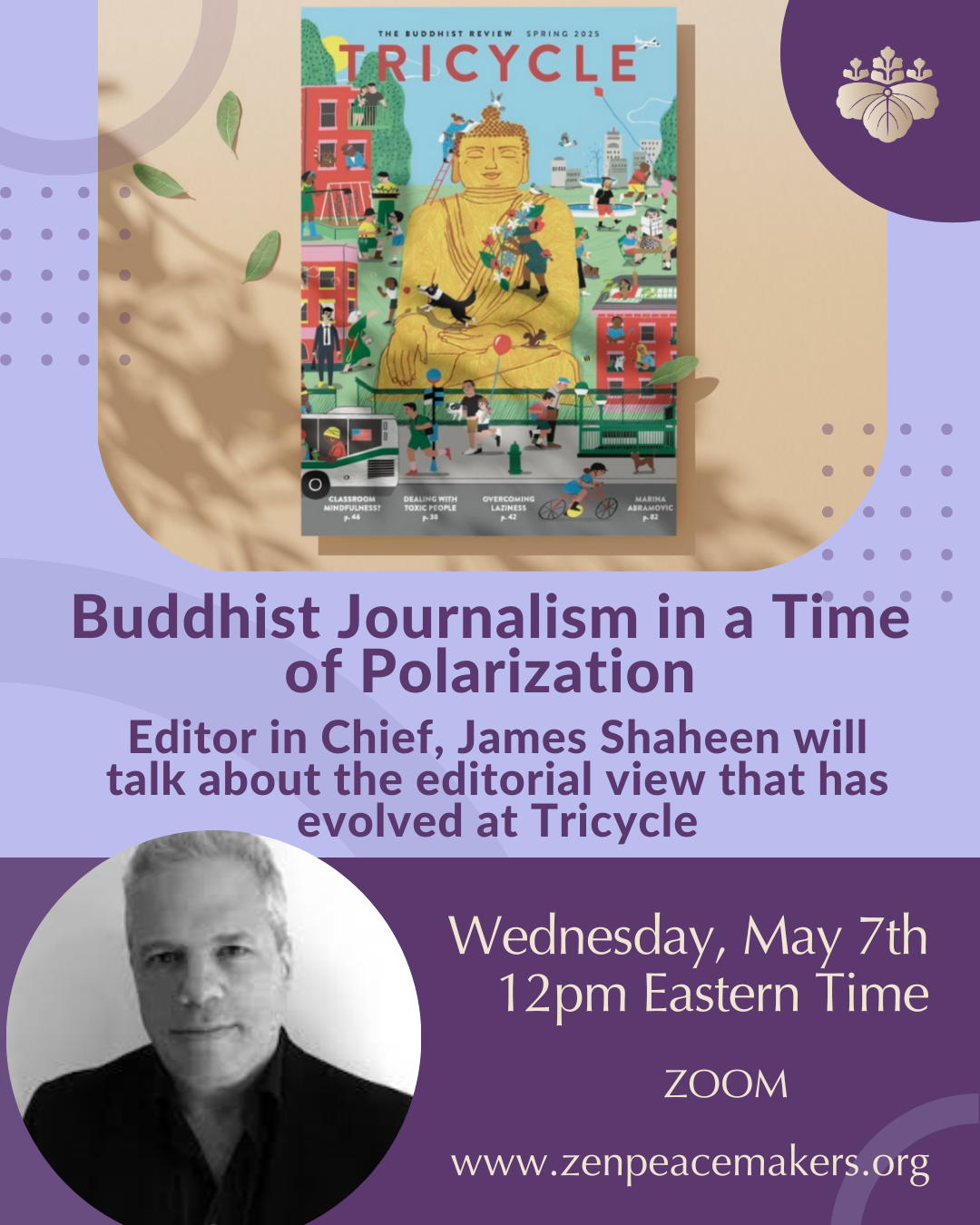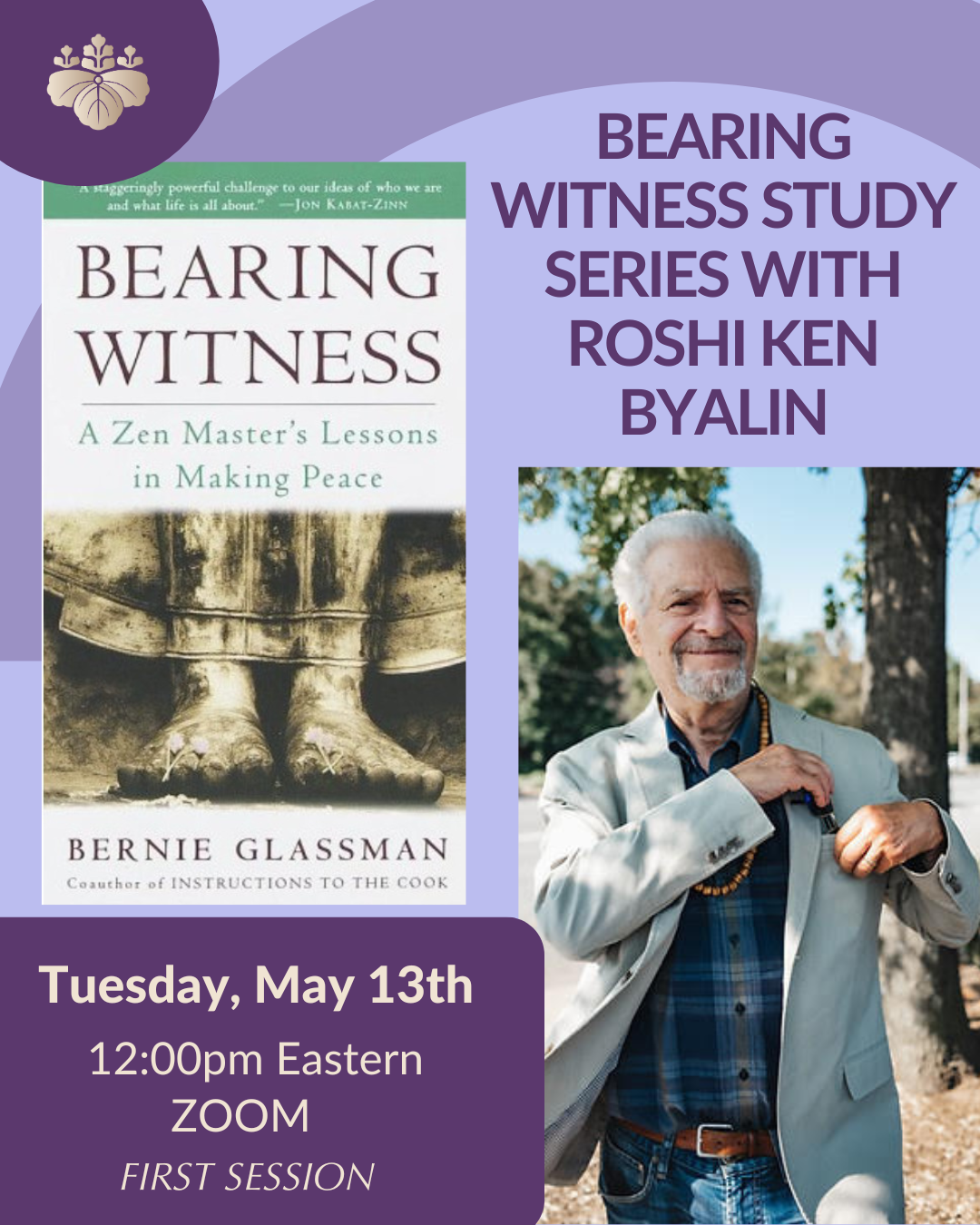Lessons from Alabama May 2022
Zen Peacemakers’ Bearing Witness to Racism in America Retreat
Four Posts with Four Photos
By Ellen Krause-Grosman
#1: May 8, 2022
“What happened here in Alabama was a human rights issue not a civil rights issue. In this case the marginalized community was black.” Timarie, a local racial and social justice activist in Birmingham whose great uncle was murdered by the Klan for being a union organizer, spoke to our Bearing Witness to Racism in America retreat group at our opening gathering last night. After watching a montage of the faces and names of Black folks killed by police or lynched she asked us to remember that they each had plans and families and lives interrupted. Her call to action for each of us is “What are you going to do with this experience? What is your piece?”
This morning in Birmingham my piece is sharing a snapshot of my experience with you and asking you what is your next step in your learning journey about racism? What are you doing today to dismantle racism and build a just world? To be a good ancestor in the words of Layla Saad. Last night as we set the container for the retreat everyone shared their name and a word or phrase about what they were feeling. My word is gratitude.
The gratitude expressed In the Shehecheyanu prayer:
I am grateful to be alive and to be sustained to reach this season.
I am grateful for the teachings of Bernie Glasman and the Zen Peacemakers’ tradition of bearing witness retreats where a group of people can gather to share a learning, heart opening journey and draw strength and inspiration from all we encounter and from each other. And then continue to ask the question “what is my response? What is my action?” Now begins Day 2.
#2: May 9, 2022
«It shall be unlawful for a Negro and a White person to play together or in company with each other in any game of cards, dice, dominoes, checkers, baseball, softball, football, basketball or similar games.» ORDINANCE 798-F Birmingham, Alabama. The list of games was expanded in 1944.
Laws restricting play? We love to play. We are social beings built for play. Play connects us to each other and builds strong bonds. Play is why I love martial arts and sarcastic repartee at the dinner table with my teens, why they play sports with their friends and we play games with our Shabbat dinner guests. I married my husband because he knows how to play. We laugh a lot at my house. We have hosted over 60 students from over 20 countries in the last 17 years and we know how to play with all kinds of people. Because people are built for laughter and play and connection and caring community.
So much of what I learned today in Birmingham at Kelly Ingram Park and in Montgomery at The Legacy Museum: From Enslavement to Mass Incarceration gave 3-D solidity to things I knew as headlines. I had heard of segregation and Jim Crow laws but did not know that the project to separate human beings by skin color in the South got as granular as laws forbidding play. It speaks to the insanity and inhumanity of the project. The 1896 Supreme Court ruling in Plessy vs. Ferguson makes «separate but equal» laws for blacks and whites legal and solidifies the way for a century of increasingly restrictive laws, that with the end of Reconstruction and the federal will and support to protect Black rights in the south, creates a climate so hellish that it drives the great migration to the northern cities.
Take heed women – this history is directly relevant today to what the Supreme Court is poised to do to dismantle a woman’s right to make her own reproductive decisions – to open the floodgates to ever-increasing oppressive laws.
Two last snapshots from my day and an ask of you:
Thousands of child foot soldiers, as young as 6, left school to march in Birmingham in May 1963 and were arrested and beaten, and attacked with dogs. No one puts their most beloved children in harm’s way unless the stakes are dire. Slavery, with its oppression and disenfranchisement of Black folks, has never been allowed to end in the United States – it has been allowed to morph into sharecropping and now Mass Incarceration. President Nixon’s policy advisors are on record saying that the war on drugs and the resulting mass incarceration was intended to restrict the black community.
The difference between visiting the Holocaust Museum in Washington DC and the Legacy Museum in Montgomery is that, while antisemitism remains a problem the Holocaust is in fact over. Money is being made today off disenfranchised Black people and the system of oppression is wired into our legal system. It’s not over.
The banks we use, the insurance companies we use, and the intergenerational wealth transfer we benefit from was and is made through exploitation. We are all complicit in the present and being paralyzed in ignorance by that fact is inhuman. Please be human today and click through on one of the links at the end of this post and learn something new and uncomfortable and figure out what you want to do about it. Not once and for all but the next step for you on a journey that will not end in your lifetime. As Rabbi Tarfon used to say… It is not up to you to finish the task, but you are not free to avoid it (Pirkei Avot 2:16).
http://civildiscourse-historyblog.com/…/visualizing-the…
https://museumandmemorial.eji.org/
#3: May 17, 2022
Dear Friends and Family,
I have some reflections on my time in Alabama to share which are different than what I imagined when I left 11 days ago. My father is in ICU and likely on his last journey. I love him and it’s sad to lose him. When I left for Alabama he was in the hospital where he had been for 1 week, in relatively good shape for him, after a bout of COVID. He was waiting for a rehab bed in a COVID ward. Halfway through my time in Alabama he got a fever and increased oxygen needs and went to ICU.
A week ago yesterday, on Monday, I spend the day in Selma walking the Edmond Pettus Bridge, learning the history of the Civil Right movement – Bloody Sunday, Turnaround Tuesday, the walk from Selma to Montgomery; meeting Jorge, the park ranger from Puerto Rico, and learning how he came to work at the parks service education center in Selma; how they could use some more volunteers for Jubilee weekend, the first weekend in March when this history is celebrated and commemorated; wondering if I could organize a group of parents and students from Rachel’s new high school to come down and volunteer with the parks service in Selma and help with Jubilee weekend and visit the Legacy Museum in Montgomery.
I meditated underneath the Edmund Pettus bridge with the torn-out seats of a car and piles of trash and 40 members of Zen Peacemakers. We saw the vines reclaiming the commemorative plaques and the rotted and broken boards in the park celebrating this history. I spent the hours before and after lunch working in the heat with Selma’s public works service carefully picking up broken glass from around a playground on the banks of the Alabama River while my friends mulched plants and picked up trash. I sat in council, with my small group, listening and speaking our truth, lean of word, saying only what needs to be said – which is when the phone rang and I stepped away.
Thus began the first of many conversations with doctors where, after getting a clear understanding of how my dad was doing and the goals of the conversation, I explained the complex family dynamics and approaches likely to be most successful with my family members and added my mother into a three-way call with the doctor and listened. That first call is when we put the DNI and DNR into place and changed the parameters for the medical team. I called my husband Michael and he brought my mom to the hospital where they made a one-time exception to the COVID restrictions and let her in to see Dad in the context of the DNR DNI discussion.
With Michael’s support, I made the choice to stay in Alabama and finish my journey because there was nothing I could do back in Boston as, due to COVID restrictions, I would not be allowed to visit my father. Michael likes to help, and he spent the next morning taking my mom to the hospital where they waited 4 hours so she could look at my dad through the glass door to his ICU room and wave to him.
I spent a meaningful morning with three new friends eating breakfast at the Waffle House and walking around the Alabama State House with its huge monument commemorating the glory of the Confederacy and its many tablets commemorating the bicentennial of Montgomery. We walked the arc of the tablets backwards, staring with the aspirations for the 21st century and making our way back to the dinosaurs roaming the shallow seas. While black leaders like George Washington Carver were mentioned in the text on the tablets, most of the images of “200 years of success” in Montgomery were White men. With one exception, the many statues in the parks around the statehouse were all of White Christian men. The exception is a Black woman, holding the hands of a Black child and a White child, representing Education for Commerce which stands opposite a statue of 2 White men representing Commerce and Education.
I googled Albert Patterson, who is commemorated with a statue by the statehouse, and learned that he was a Democratic candidate for Alabama Attorney General who was assassinated in 1954 by the organized crime he threatened to clean up. I visited Jefferson Davis’ first White House of the Confederacy and saw photos of the United Daughters of the Confederacy, who in 1900 built the huge monument to the glory of the confederacy which stands on the State Capitol lawn, and in 1921 moved this house across the city to sit near the Capitol building to commemorate the few weeks that Montgomery was the capital of the Confederacy before it moved to Richmond. Who were these white women whose tragic loss of their husbands and sons and whose commitment to the glory of White Supremacy drove them to fundraise, build and commemorate the Confederacy into the 1940’s? What did Jefferson Davis do for the 24 years after the end of the Civil War?
We wandered the abundant memorials of the Montgomery Capital area asking questions and sharing observations. It was such a rich morning with friends, encountering history we did not know. Our last stop before we joined the group was at the Civil Rights Memorial of the Southern Poverty Law Center which was designed by Maya Lin of Vietnam Memorial fame. I stood with my hands pressed up against the black stone wall, below Martin Luther King’s words, “Until justice rolls down like water and righteousness like a mighty stream.” As the sheet of water rolled over my hands I cried.
#4: May 18, 2022
After a morning spent exploring the Montgomery Alabama Capitol monuments
I rejoined my group to walk silently to the National Memorial for Peace and Justice, “the nation’s first memorial dedicated to the legacy of enslaved Black people, people terrorized by lynching, African Americans humiliated by racial segregation and Jim Crow, and people of color burdened with contemporary presumptions of guilt and police violence.”
Just as entering the Legacy Museum had the familiar feeling of visiting the Holocaust Memorial in Washington DC, entering the National Memorial for Peace and Justice had the familiar feeling of entering Yad Vashem, the World Holocaust Remembrance Center, in Israel. On this beautiful green hillside in Alabama there are different memorials centered around a square complex with a walkway that brings you face to face and then under over 800 large metal monuments which commemorate over 4400 documented lynchings in the US. Each metal monument has the name of a county and state where lynchings happened and a list of the names and dates of the people who were lynched. When you enter to walk among these columns your feet are on the ground, at the same level as the base of the columns and you see each one with its list of names at eye level. Names of people you know, like Gabriel and Michael, my son and husband’s names. As you continue to walk through the pavilion, you descend until you are walking below the coffin like monuments, which are now suspended above you as black bodies were suspended from tree limbs while white communities picnicked and celebrated their murder and torture.
You read bands of text with the justification for racial terror lynchings: people were lynched for being human – for being successful and refusing to sell their crops at unfair prices, for loving someone, for talking back to disrespectful treatment, for speaking out against lynching.
It is profound and overwhelming to stand among these monuments and contemplate the number of people whose lives were taken and whose families and communities were terrorized by White people asserting White Supremacy. That morning, at the first White House of the Confederacy, I learned that at the time of the Civil War 1/3 of Alabama’s voting delegates voted to stay part of the union, which was not uncommon in Confederate states. Many White people abhorred lynching and racial terror but for decades there was not the national political will to pass a federal anti-lynching bill or provide the law enforcement needed to stop it. This terror shaped our country by driving a mass migration of 6 million Black people out of the south to the northern cities in the early years of the 20th century.
After exploring the monument and the memorial grounds, I came back to sit by the wall of water near the end, inscribed with:
For the hanged and beaten.
For the shot, drowned, and burned.
For the tortured, tormented, and terrorized.
For those abandoned by the Rule of Law.
We will remember.
With hope because hopelessness is the enemy of justice.
With courage because peace requires bravery.
With persistence because justice is a constant struggle.
With faith because we shall overcome.
I read the quote over and over again and promised myself I would memorize this passage. I decided I would make a monthly contribution to EJI’s work which includes a duplicate monument for each of the 800 counties where lynchings have occurred which they can claim and install to commemorate this important tragic history. For it is through knowing our collective history that we can heal and build a just society. I contemplated the line: “With persistence because justice is a constant struggle.” over and over again. It reminded me of a Thomas Jefferson quote I often cite, “The tree of liberty must be watered by the blood of Patriots every 20 years.” They mean the same thing to me: we are not “there yet” and we cannot be like small children on a long car trip just waiting to “get there”. The struggle for a just society never ends. We are all called to act again and again.
Just before COVID my friend Ann, an African American filmmaker in NYC, took me to the Ford Foundation to see the opening of the PBS Independent Lens film Always in Season, a documentary about a suspicious death of a young Black man who was dating a White woman which “shows us America’s history of lynching isn’t history at all.” His mother spoke afterward describing how some of the Police in her town were related to the person who she thinks hung her son which is why she believes the death was determined to be suicide without consideration of the forensic evidence. Still today, unlikely hanging deaths of men of color are deemed suicide and go un-investigated. Did you know that lynching is still going on in the US today? I did not. What are we going to do about it?
Ann and I met at community access t.v. back in the early 90’s when we both worked in documentary film and we became fast friends. She worked on Eyes on The Prize at WGBH, while I worked in television research. Most days I stopped by to say hi to Ann and the folks in the Eyes on The Prize office. She has continued to work on films that educate all of us about black history and how it is still unfolding. Because I love Ann and want to know how she is doing and what she is working on I learn things I would not otherwise know.
I really only have three close black friends: Ann, Maryam, and Gina. Maryam and Gina are Jersey girls like me, but not like me. Maryam grew up Black Muslim and Gina is from a family of Haitian revolutionaries, forced to leave Haiti because of their political activism. I met Maryam at a Daughters of Abraham book group gathering where we stayed late talking for hours. Pre-COVID she was a regular at our family Friday night shabbat dinner table. We all miss her. She picks out the Muslim books for our book group and my understanding of the world is so much bigger because of the books that Maryam has shared. She is an amazing educator with a commitment to interfaith work.
After 20 years of not spending much in-person time together, Gina lived with us for 6 months last year during the pandemic. She is a brilliant poet, anthropologist, and intellectual whose deep understanding of social theory is so far beyond my own. She is also a great person for my 17-year-old, Gabriel. to talk to about college choices because she appreciates his intellect and sensibilities and has well-informed opinions on where he might thrive.
I am committed to looking at hard history because I love my friends and family,
Because I am Jewish and my world has been touched and shaped by hard history, Because I am American, and the life of my country is being shaped by hard history, Because I am a woman and we are always fighting for our rights,
Because I am human and we are destroying each other and destroying our ecosystems, Because I am a parent and want a just world for myself and for my children and for everyone else and for their children.
African American history is White American history is American History. Black Lives Matter asked White people to educate ourselves about Black American History. Whether you identify as White or not, my request to you is that you say “yes” to that ask and figure out what your next step is on your learning journey and tell me about it. Read EJI’s website. Watch a film. Read a book or an article. Choose your own adventure and report back. It’s important because it will change you and change how you show up which affects all of us. Act “with persistence because justice is a constant struggle.”
Post Script: Last Wednesday my plan was to revisit the Legacy Museum to spend time in the Mass Incarceration Section which I had missed the first time. I had lunch at the museum with friends after a zoom job interview in my hotel room but never made it back inside the Legacy Museum because the doctor called to say that my father’s oxygen needs were maxing out the BIPAP machine and we needed to decide how many more hours to keep him on it. I went to the airport early because my father’s impending death was all the hard that I could handle at one time.
On Thursday my sister called from Israel to say that she was coming.
On Friday we picked her up at the airport, had dinner with mom, and all went to the hospital for a family meeting and got to go in and see Dad who was still under COVID restrictions.
On Saturday, after another call from the doctor, I left my Emerge Democratic Women’s Candidate’s training to join the family at the hospital to take off the BIPAP and shift my dad to “comfort care” which does involve morphine but does not involve food and water. In that context all restrictions were removed and the family could stay as long as we wanted. My kids came. Gabriel played the violin. My sister played guitar and we all sang to my father who loved music and used to be the life of the party at the NJ Family Law Section meetings with everyone gathered around the piano while he played from fake books. They switched him over to regular oxygen and we waited, having been told that he would last less than a day. We are entering day 4 of Dad resting peacefully, not conscious, with my sister in his hospital room 24-7 singing to him, and my mother and me visiting each day.
My dad spoke Spanish, Portuguese, French, some German and studied Romanian, Ladino, and Catalan. He helped organize Freedom Bus Rides while he was a grad student in Political Science at Yale in the 50’s, and was Fidel Castro’s translator when he worked summers for the State Department, before Castro was a communist. As a lawyer his practice included immigration law. He kept the family law office in Newark until the 1980’s and I am one of the only White girls from Short Hills NJ whom I know who spent my childhood weekends hanging out in Newark in the ‘70’s.
My father taught me how to crash parties, write good papers the night before they are due, and connect with and love people of all backgrounds for which I am grateful. The time that my sister and I are spending this week talking and singing by his bedside is a gift from him.
PPS From the Equal Justice Initiative’s FAQ:
Why Build a Memorial to Victims of Racial Terror?
EJI believes that publicly confronting the truth about our history is the first step towards recovery and reconciliation. A history of racial injustice must be acknowledged, and mass atrocities and abuse must be recognized and remembered, before a society can recover from mass violence.

